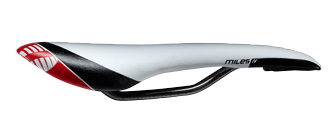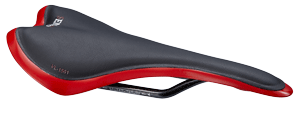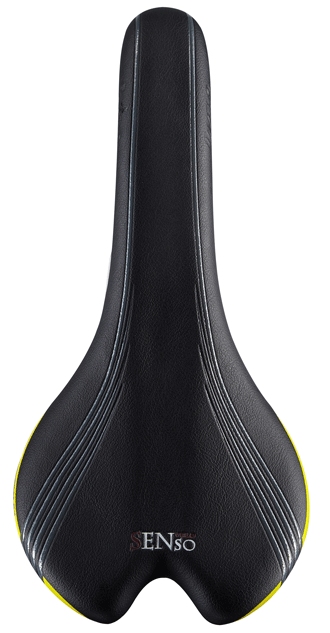 |
|
Questions
for the Saddle Expert Stella Yu  President of Velo Enterprise Co., Ltd. What are some of the different saddle shapes and designs available these days? Each saddle is
created for a specific type of cycling and cyclist, with
unique shapes and designs to fit every saddle need. Saddles for the
recreational cyclist tend be broader, providing greater cushioned
comfort in a traditional sense.
Performance and competition saddles emphasize high-tech comfort; meaning materials and saddle construction are optimized for weight, aerodynamics and comfortable support over the long haul. Our Senso Aftermarket line offers four different saddle categories: Competition, Performance, Recreational and Pivotal. Our Competition and Performance saddles are sleek, lightweight constructions with patented cushioning, ventilation and suspension systems to enhance comfort with minimum weight and utmost performance.  Senso Miles 1491 Models specially developed for the MTB, BMX, Cyclecross, Road and Endurance categories include Miles 1200, 1501 and 1491, and the Pivotal saddle system designed for street, FMB and trick. These are the saddles preferred by the Velo New Heroes athletes for their exceptional performance and style, and those being specially featured for 2012 at this summer’s Eurobike.  Senso Miles 1200 Does a saddle with more padding mean it’s a better saddle? Why/Why not? No, a saddle with
more padding is not automatically a better saddle. In
fact, I don’t think “better saddle” is the right term to use here. A
saddle should be “suitable” to the riders’ needs. Saddles are very
personal pieces of equipment.
The important factors in choosing a saddle are what type of rider you are, and how you use your saddle: Endurance cyclists experience better support, relieving the Ischia nerve and minimizing chafing, with a minimum of padding. Less ambitious recreational riders appreciate increased padding, when riding shorter distances. Our Plush line offers comfortable, sporty-looking saddles for the recreational cyclist. Newest in the line are the Relaxed Models Tour-e Sport 6220 and 6221, which are specially recommended for e-bikes. What should mountain bikers consider when shopping for a saddle? Mountain biking is
not a speed sport like road racing, and mountain
bike paths do not have the good surfaces of regular roads. Therefore,
more experienced mountain bikers and BMX riders should consider
selecting a streamlined saddle with strategic padding and a
high-quality suspension system specially designed to take heavy
pounding and enable movement, such as the Miles 1200 and Miles 1501
carbon base and suspension saddles. Cyclist should select their saddles
according to their riding abilities: advanced riders usually select a
saddle for its support qualities to enhance performance, while
beginners often prefer added comfort and additional suspension.
 Senso Miles 1501 How can a mountain biker know if a saddle is the right fit? This is a very
subjective and personal decision! Choosing a saddle
classified for your riding ability – beginner to advanced – is a good
start. Seeking professional advice from bike shops with individual
service and personnel trained in cycling ergonomics is the best choice
when choosing a suitable mountain bike saddle for your anatomy and
cycling aspirations!
What is the best way to test a saddle before buying? 1. First of all,
consumers should actually take and hold the saddles in
their hands to get a feel for the saddles’ lightness, resiliency and
comfort.
2. Getting professional advice from a reliable dealer regarding form, length and width for your body type, as well as actually testing the products, is the recommended second step. 3. Testing the saddle under real road and track conditions is certainly the best way to decide if the saddle is right for you or not. If you only try out the saddle in a limited testing situation, you won’t get the actual feel of the saddle on the long run.  Senso Miles 1491 What are the features of a saddle and how can they impact a ride? (shape, rails, cover, etc.) Each mountain bike saddle has its own unique features. To choose a suitable saddle, you need to consider a number things, like what type of roads you’ll be riding, how old you are, how fast you want to ride and what special requirements you have for various disciplines like Freestyle, Dirt or Slope. After evaluating these variables with a knowledgeable bike dealer, you’ll be able to choose the appropriate shape, firmness, resilience, cushioning and materials for your needs. Can an improperly positioned saddle cause discomfort? Please explain. Of course, every
saddle should be properly positioned to maximize
performance and functions. A poorly positioned saddle can lead to all
kinds of aliments over the short or long term, so it is best to let an
expert set up your saddle for the first time with you, and consult an
expert if you are experiencing discomfort or early fatigue when cycling.
What do you recommend for cyclists who experience numbness or discomfort on a regular basis? Numbness and
discomfort are signs of an ill-chosen saddle, poor saddle
positioning or both. Sitting on a saddle for longer periods of time,
nerves can compress, especially when the ischial tuberosities isn’t
properly supported. Bike shops and dealers are professionally trained
to advise you in this area, so it is good to consult them early on with
such problems to avoid lasting
effects. Velo will more than happy to help out with some suggestions if
he or she contacts us.
How often should saddles be replaced? Generally
speaking, a good saddle should not need replacing under 5,000
riding miles (8,000 km) unless damaged by external force. On the other
hand, if riders rely on one bike for various types of cycling, they
should consider having different saddles for each riding purpose.
What are some signs of wearing that a cyclist looks for? A good saddle is
durable and, even after a long time, it will still be
fully functional and offer consistent performance. However, after 5,000
riding miles (8,000 km), even a good saddle may show wear on the cover
or cushioning. Of course, a saddle should always be checked after
collision or other extreme external force.
For more, visit Velo at: www.velosaddles.com . |
You also might like:
| Training Health and Fitness  |
Archive  |
Tips and Safety  |
Store  |
Links |
Talk |
Have
something
you would like
posted? News tips? Events? Upcoming rides? In store specials? Send it
to info@dougreport.com.
(Readers are encouraged to send links to current stories
about cycling that appear in the media. If you come across a news item,
send it in as it may benefit our cycling community)
